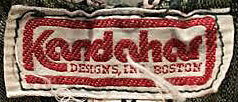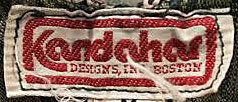Kandahar Designs has an interesting backstory.
In 1970 or 1971, Eli Zelkha was heading down to Florida for spring break with Archie — (his last name is never revealed), a pre-med college mate from Colgate University in upstate New York. On the trip down they talked about what they would be doing that summer. Archie had $5,000 and suggested the two go to Afghanistan to buy ‘cool stuff’ to resell. During their summer they purchased a very expensive Bengal tiger skin rug, scores of antique 19th century Afghani rifles, and 800 men’s wedding shirts from dealers in Kabul.
When their purchases arrived in the United States, the tiger skin rug was confiscated, there was no interest in the rifles from collectors, and the shirts were used, stained, and mis-sized. All they could do was try to salvage what they could from the shirts, so they dyed them to cover the stains and then consigned them through boutiques. One shop offered to share his booth at an upcoming New York sale in lieu of payment for some shirts, and the shirts were a hit. Mademoiselle magazine snapped some up for a fashion shoot, and other fashion mags and leading stores followed.
The next problem was filling orders. By 1972, Eli and Archie had moved from being importers to manufacturers when they hired tailors in Afghanistan to make the items to order. As the interest in ethnic clothing grew, especially after Yves St. Laurent’s success with ethnic-inspired collections, the two expanded the business, hiring fashion designers to remake Afghani clothes and textiles into Western styles, like sundresses.
The venture was a huge success until 1979 when the Iranian revolution lead to Russia invading Afghanistan. Even though ethnic fashions were already cooling in popularity, Eli bought out Hindu Kush, a competitor clothing business that sourced similar clothes. He then attempted to shift production to different styles of clothing, but the business failed.
The owner of Hindu Kush was Tom Freston who went on to found MTV in 1981, and Eli Zelhka went on to head the team that invented Ambient Intelligence in 1998.
Written by Fashion History Museum, Cambridge, Ontario

